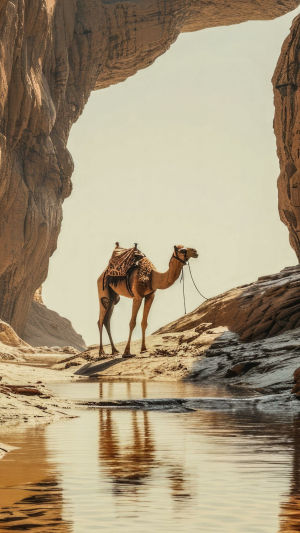Camels are big land animals famous for their humps. There are three types: dromedary camels with one hump, Bactrian camels with two humps (both wild and domesticated). Dromedary camels make up 90% of all camels. Wild Bactrian camels, with only around 1,000 left, are in critical danger.
Hey Lykkers, today, let's explore what makes camels so fascinating and unique, from their ability to store energy in their humps to their efficient rehydrating skills.
<h3>1. Camels Don't Store Water in Their Humps</h3>
The camel's hump is its most notable feature. However, contrary to popular belief, it isn't used to store water. Instead, the hump stores fat, which the camel uses as a source of energy and water when resources are scarce. This fat storage also helps camels stay cooler in the desert by preventing them from being covered in insulating fat all over their bodies.
Healthy camels with substantial fat reserves can survive for weeks without food or water.
<h3>2. They Are Built for the Desert</h3>
Camels are well-adapted to survive in harsh desert environments. They have three eyelids and two sets of eyelashes to keep out dust and sand. Their thick lips enable them to eat thorny plants that other animals cannot. Thick pads on their chest and knees protect them from hot sand, and their large, flat feet prevent them from sinking into the sand as they walk. Camels can even close their nostrils to keep out dust.
Additionally, all parts of their body that touch the ground when they lie down are padded, allowing them to rest comfortably for long periods.
<h3>3. They Can Hydrate Quickly</h3>
Even though camels don’t store water in their humps, these desert animals are excellent at conserving water. Dromedary camels use heterothermy to regulate their body temperature throughout the day, which helps them avoid sweating during temperature spikes and thus conserve water. When camels do find water, they can drink astonishingly fast, consuming as much as 26 gallons in just 10 minutes.
<h3>4. They Provide Nourishment</h3>
Camel's milk, lower in cholesterol and richer in vitamin C, sodium, and potassium compared to other ruminants' milk, is considered closer to human milk.
<h3>5. They Sleep Somewhat Unusually</h3>
Camels do sleep, but their sleeping patterns differ somewhat from other large mammals. On average, they sleep only about 1.7 hours out of a 6- or 7-hour night, which includes both REM and non-REM sleep. The remainder of the time, they are either drowsing, ruminating, or awake. They move between these states, likely to stay alert and vigilant. Interestingly, drowsiness is considered part of their sleep cycle. Camels can sleep standing up or lying down.
Hey, did you know camels only sleep for about 1.7 hours a night? It's crazy how they mix naps with staying alert! Imagine having those survival skills in the desert—no wonder they're so resilient.





